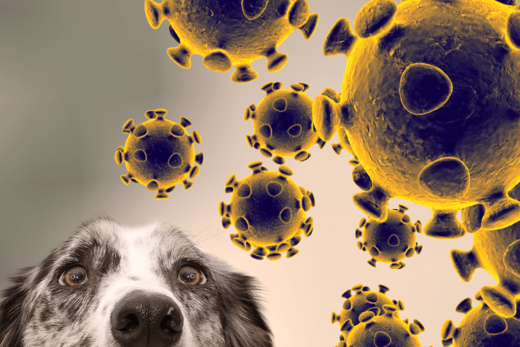Ringworm is a condition that usually does not resolve itself, so medical attention from a professional is needed to relieve the problem. Ringworm is caused by the build-up of fungus in certain ways, and it takes the shape of a circle or a ring. The skin condition is not often a filled-in circle, though it can be in more severe cases.
Most commonly, ringworm presents as a red outline, which is the worm part of the name. It really truly does look like a worm curled up into a circle. Don’t let the name of the skin infection fool you, though. There aren’t any real worms involved. Rather, the name ringworm came about because of the way the rash looks on the skin.
TABLE OF CONTENTS
1. Dermatophytosis in Dogs: What is Ringworm?
2. Symptoms of Ringworm in Dogs
3. Can Ringworm Pass from One Dog to Another?
4. How Contagious is Ringworm in Canines?
5. Five Fun Facts That You Might Not Know about Ringworm in Dogs and Cats
6. How to Relieve Your Dog of Ringworm at Home
7. Ringworm Treatment Options
8. CBD for Ringworm in Animals
Dermatophytosis in Dogs: What is Ringworm?
Another term for ringworm is dermatophytosis. The fungus that causes ringworm feeds off of keratin. As a protein naturally found in skin, keratin is most densely located in nails, at the origin of hair follicles, and in skin. For this reason, ringworm most often presents itself in these parts of the body.
Ringworm is also very commonly found in places that hair, nails, or infected skin come in contact with, such as a leg that is scratched by a ringworm-affected fingernail or parts of the back that are often touched by hair stemming from scalp ringworm.
Can Dogs Get Ringworm?
Now that we know the background information on ringworm, let’s focus on how ringworm can potentially affect your dog. For starters, can dogs get ringworm? The short answer is yes, dogs are susceptible to ringworm.
Do Cats Have Ringworm, Too?
Just like dogs, cats can get ringworm very easily. In fact, there is nothing stopping a cat from coming down with a case of ringworm after coming in contact with a dog that has the same skin condition. Ringworm is not specific to one species, and the idea that dogs can only contract ringworm from other dogs is not true. The same goes for cats. Felines are capable of coming down with a case of ringworm after playing with an infected dog, and the same goes for healthy dogs and infected cats.
Symptoms of Ringworm in Dogs
The symptoms of ringworm are not terribly hard to spot, but if you don’t know what to look for, you might not even recognize the symptoms as being a sign of ringworm in dogs.
A few symptoms of ringworm in dogs include:
- Alopecia on faces and paws
- Seborrhea sicca
- Scaly skin
- Odd changes to the surface of the skin
- Hair follicles that are clearly inflamed and reddened
- Infections at the root of hair follicles
- Hair loss
Can Ringworm Pass from One Dog to Another?
Ringworm thrives in warmer temperatures, and this doesn’t only apply to the weather conditions in your area. It can also relate to warmer parts of your body, like your legs when wearing pants or underneath your arms. For dogs and cats, the warmer parts of their bodies tend to be their underbellies and near their joints, as well as around the neck, especially if they wear a collar.
Ringworm spreads very quickly, and there aren’t many limitations when it comes to what can and cannot be affected by ringworm.
The eight main instances where ringworm will spread from one person, place, animal, or object to another are:
- Person to person
- Animal to animal
- Person to animal
- Animal to person
- Object to person
- Object to animal
- Environment to person
- Environment to animal
How Contagious is Ringworm in Canines?
Ringworm from dog to person, environment, or another pet is a very common occurrence. The reason for such rapid and easy transmission of ringworm from one person, place, animal, or object to the next is due to the contagiousness of ringworm. Ringworm remains contagious until the moment it disappears, so please do not think that the treatment process automatically makes your pet all better. You should still keep your dog away from other canines, felines, and people until every bit of ringworm is gone.
It’s important to gently wash your dog’s skin and fur when they have ringworm, but it’s even more important that you don’t leave the area damp. Pat the infected space using a soft towel until it is dry. Leaving behind traces of moisture will contribute to the ringworm problem rather than lessen the severity. Damp surfaces in warm environments never result in anything beneficial, and that fact remains true in the case of dogs with ringworm.
Do your best to keep the infected area exposed to the open air, if possible, but if that poses more of a risk, then a clean bandage, wrap, or any sort of covering can help protect your dog’s skin until the ringworm issue is fully healed. Also, another tip for treating dogs with ringworm is to treat other parts of the body that often come in contact with the infected region. For example, let’s say the back of your dog’s neck is the location of ringworm.
Try to walk yourself through the motions your dog makes throughout the day and figure out what other parts of your dog’s body touches the back of his or her neck daily. Your dog likely scratches the back of their neck with a back foot or front paw. Even if your dog’s paws do not show signs of the presence of ringworm, they could potentially still have very miniscule traces of keratin embedded between the toes, pads, or claws.
In order to keep your dog’s feet from making the ringworm on their neck that much worse, treat your dog’s feet the same way you do the ringworm on their neck. That way, it’s impossible for ringworm to travel from feet to neck, or from neck to feet, because you are covering all the bases by treating both locations. On a related note, your dog is less likely to transmit the skin condition to other dogs, cats, or people because you are making sure to fight ringworm at every possible spot.
Other attributes that heighten the risk of ringworm include…
- Weak immune systems by nature
- Diseases that weaken the immune system
- Close proximity to a person or animal that already has ringworm
- Warm, muggy, and humid environments
- Brushing against fungus on common and shared items





